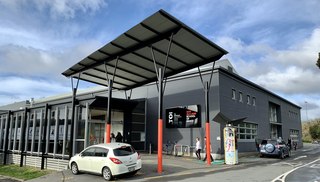Wellington City Libraries is the public library service for Wellington, New Zealand.

Toi Whakaari: NZ Drama School is New Zealand's national drama school. It was established in 1970 and is located in Wellington, New Zealand in the Te Whaea: National Dance & Drama Centre. Toi Whakaari offers training in acting, costume construction, set and props construction, performing arts management and design for stage and screen. Toi Whakaari has a roll of approximately 130 students annually, who study for up to three years.
Tungia Dorothea Gloria Baker was a New Zealand actor, weaver, and administrator. Her notable acting roles included Ngahuia in the 1980s television drama Open House and Hira in the 1993 film The Piano. Baker was influential in contemporary Māori theatre, Māori film making and Māori arts. She named the Taki Rua Theatre, and was a founding member of Māori artists' collectives Te Manu Aute and Haeata.
Apirana Taylor is a New Zealand poet, novelist, performer, story-teller, musician and painter.
Rangimoana Taylor is an actor, theatre director, storyteller from New Zealand with more than 35 years in the industry. He has performed nationally and internationally and was the lead in the feature film Hook Line and Sinker (2011). He was an intrinsic part of three Māori theatre companies, Te Ohu Whakaari and Taki Rua in Wellington and Kilimogo Productions in Dunedin.
Maaka Pohatu is a New Zealand actor and musician. Pohatu is also a founding member of Māori showband the Modern Māori Quartet. He co-wrote and performed songs, with the other band members, for the Modern Māori Quartet's debut album That's Us! (2017).
James Tito is a New Zealand actor and musician. Tito is also a founding member of Māori showband the Modern Māori Quartet. He co-wrote and performed songs, with the other band members, for the Modern Māori Quartet's debut album That's Us! (2017).
Raymond Stanley Boyce was a British-New Zealand stage designer, costume designer and puppeteer and puppet designer. Boyce was part of the start professional theatre movement in New Zealand influencing the artistic landscape with his design knowledge. Boyce designed hundreds of theatre shows and was named an Arts Foundation of New Zealand Icon in 2007.
Ahilan Karunaharan is writer, director, actor and producer of Sri Lankan descent from New Zealand. He is a recipient of the New Zealand Arts Laureate Award.

Rona Bailey was a New Zealand drama and dance practitioner, educationalist and activist. Bailey was influential in emerging contemporary dance and professional theatre in New Zealand. She was an activist in the anti-apartheid movement in the 1970s and 1980s, and part of Treaty of Waitangi anti-racist education that started in the mid-1980s.
Sunny Amey is a theatre director and educator born in New Zealand. She worked at the National Theatre of England during its formative years alongside Laurence Olivier, as artistic director of Downstage Theatre in the 1970s and the director of New Zealand's national drama school Toi Whakaari in the late 1980s.

William Newton Sheat was a New Zealand lawyer and arts advocate whose input was instrumental in many arts organisations including as a founding member of the New Zealand Film Commission, Creative New Zealand and Downstage Theatre.

Performing arts in New Zealand include amateur and professional presentations of theatre, circus, dance and music where it accompanies live performance. Aotearoa New Zealand has an active contemporary performing arts culture; many people participate in performing arts activities and most people live near an arts centre or theatre building.

The New Zealand School of Dance was established in 1967 and is a tertiary educational institute in New Zealand that teaches contemporary dance and ballet. It started as the National School of Ballet, and after contemporary dance was added in 1982 the name was changed to the New Zealand School of Dance.
Alexander Tarrant-Keepa, known professionally as Alex Tarrant, is a New Zealand actor. With multiple TV and film credits, he currently portrays Kai Holman in the CBS action crime drama NCIS: Hawaiʻi and Valandil on Amazon Prime's The Lord of the Rings: The Rings of Power fantasy drama.
Jason Te Kare is a New Zealand director, playwright and actor.
Entertainment Technology New Zealand (ETNZ) formed in 2002 is a professional association for the design, management, craft and technical performing arts and events community in New Zealand.

David John O'Donnell is a theatre director, actor and academic based in Wellington, New Zealand. He has been a full professor at Victoria University of Wellington since 2019.
The Winter Show Building in John Street, Wellington was built in 1928 by the Wellington Show Association as a permanent home for the Winter Show, an annual trade fair promoting agriculture, trade and industrial innovations. In 1998 it became the home of Te Whaea, a national performing arts centre.

New Zealand performing arts venues are places in New Zealand that are set up to host performing arts and music events such as theatre, dance and concerts.






